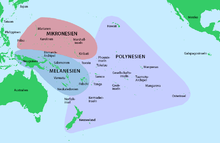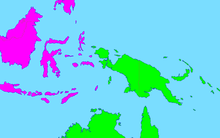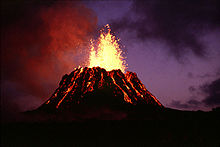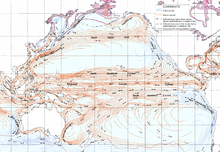Oceania
![]()
This article is about the islands of the Pacific Ocean. For the fictional state invented by George Orwell, see 1984 (novel).
Oceania
.svg.png)
![]()
Oceania is the name for the island world of the Pacific north and east of the continent of Australia. The more than 7500 islands together cover a land area of 397,000 square kilometres and extend over a sea area of about 70 million square kilometres. About 2100 of the islands are inhabited, a total of 9.9 million people live there. Together with Australia, Oceania forms the major continental region of Australia and Oceania.
Term
Oceania
The extent of the territory belonging to Oceania is defined differently. In the most common German-language definition, only Polynesia, Melanesia and Micronesia belong to Oceania. Both New Zealand and Hawaii are assigned to Polynesia, since both were settled by Polynesians, who were of great importance for their cultural development. This is also true for the present, although New Zealand has strong European features due to European immigration and Hawaii belongs to the American economic area. The classification thus excludes the East Asian island chains as well as those of the Malay Archipelago, which show a different cultural landscape development with different historical, economic and social characteristics.
Rarely, the east of the Malay Archipelago is also included. Occasionally - and especially in the English-speaking world - Australia and Oceania are also shortened to Oceania.
The area owes its peculiar nomenclature to its apparent distance from other continents. In order to unite the cultural identity of the indigenous peoples of the Pacific world in one term, the term Austronesia was formerly used for the South Sea islands inhabited by Māori and other Polynesian peoples. Gradually, the term was extended to other areas.
Transoceanic
In English, the term transoceanic is also in use. This term arose primarily for economic reasons in Australia and New Zealand and refers to an area from the north of Australia via Indonesia to the southern border of the Philippines and the extreme west of the Pacific islands. The region is of great importance to the industrialized countries in the south as a trade route to the developing and newly industrializing countries of East and Southeast Asia, as well as a source of raw materials, a location for low-cost production and a sales market.
South Pacific
The term "South Sea" was coined by Vasco Núñez de Balboa in 1513 when he crossed the isthmus of Panama and called the sea (Pacific) in front of him Mar del sur ("South Sea"), as he was looking south at the sea from his location. Central island groups are the Society Islands (French Polynesia/Tahiti), the Samoa Archipelago, and the Fiji Islands. The term South Seas is often used synonymously with Oceania and in a narrower sense with Polynesia (triangle with the corners Hawaii, New Zealand and Easter Island). Derived from this, other terms are common, such as South Pacific or South Pacific island region. In the past, these often appeared in the political vocabulary as self-chosen designations (e.g. South Pacific Forum, South Pacific Commission, University of the South Pacific). Many of these designations have been modified in recent years to give meaning to the Pacific region as a whole.

Cultural regions of Oceania

Transoceanic
Geography
Geology
Oceania is not a continent in the geological sense, since only New Caledonia and New Zealand consist of continental crust of the former continent Gondwana: Thus New Zealand, New Caledonia and the Lord Howe sill with the Lord Howe group of islands form a large piece of the former continental shelf of Gondwana, the microcontinent Zealandia. New Guinea is separated from Australia only by the shallow Arafura Sea, still during the last ice age they formed a contiguous landmass called Sahul, because at that time the water level in the Pacific was about 100 m lower than today.
Most of Oceania's islands are volcanic elevations in the Pacific Ocean, which is on average 4000 m deep, often recognizable by volcanic craters on land. In some cases the volcanoes reach just below the sea surface and are extended by corals to form reefs and shallow islands. Volcanic islands framed by a belt of coral reefs or with rock formations made of limestone formed by corals are also common. Cave structures are often found here.
Volcanic activity is triggered by geological processes in the oceanic crust. The movements of the lithospheric plates in the Pacific are also the cause of the so-called Pacific Ring of Fire, where many islands were formed, especially on its western edge. Volcanism at hotspots created long island chains far out in the ocean, such as the Hawaii-Emperor chain with the islands of Kure Atoll, the Midway Islands and the Hawaiian Islands as its terminus.
Where subduction, for example of the Pacific Plate, occurs, deep-sea trenches, island arcs and sometimes sea basins were formed. Examples include the Backarc Basin, the Laube Basin to the west of Tonga, and the Tonga Trench, which lies up to 10882 m below sea level.
Ocean Currents
At the level of the equator, the equatorial countercurrent runs from west to east in the Pacific. North, at the level of Hawaii, flows from east to west the North Equatorial Current. At New Guinea it changes into a northward current, passes east of the Philippines as the Kuroshio, and creates a huge eddy in the area of Micronesia. Part of the ocean current leaves the eddy eastward to flow to the coast of North America and return to its beginning as the North Equatorial Current. South of the equator, also running east to west, is the South Equatorial Current. This is fed by the cold Humboldt Current on the west coast of South America and merges in part with the East Australian Current, which flows along the east coast of Australia and meets New Zealand. From there an eastward current runs to South America, composed of warm equatorial water and cold water from the Antarctic Circumpolar Current running south of Australia and New Zealand. As a result, New Zealand is surrounded by a warm ocean current to the north and a cold one to the south.
Climate
The tropical to subtropical Pacific islands in eastern Oceania offer little year-round variety and are home to a variety of rainforest forms due to their hot and humid climate. The high precipitation winters in the east and the monsoon in the northwest (Indonesia, Papua New Guinea) raise the annual mean here significantly.
An exception here is New Zealand, where cool temperate climates predominate.

Kilauea in Hawaii

pacific ocean currents
Search within the encyclopedia